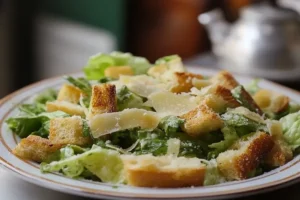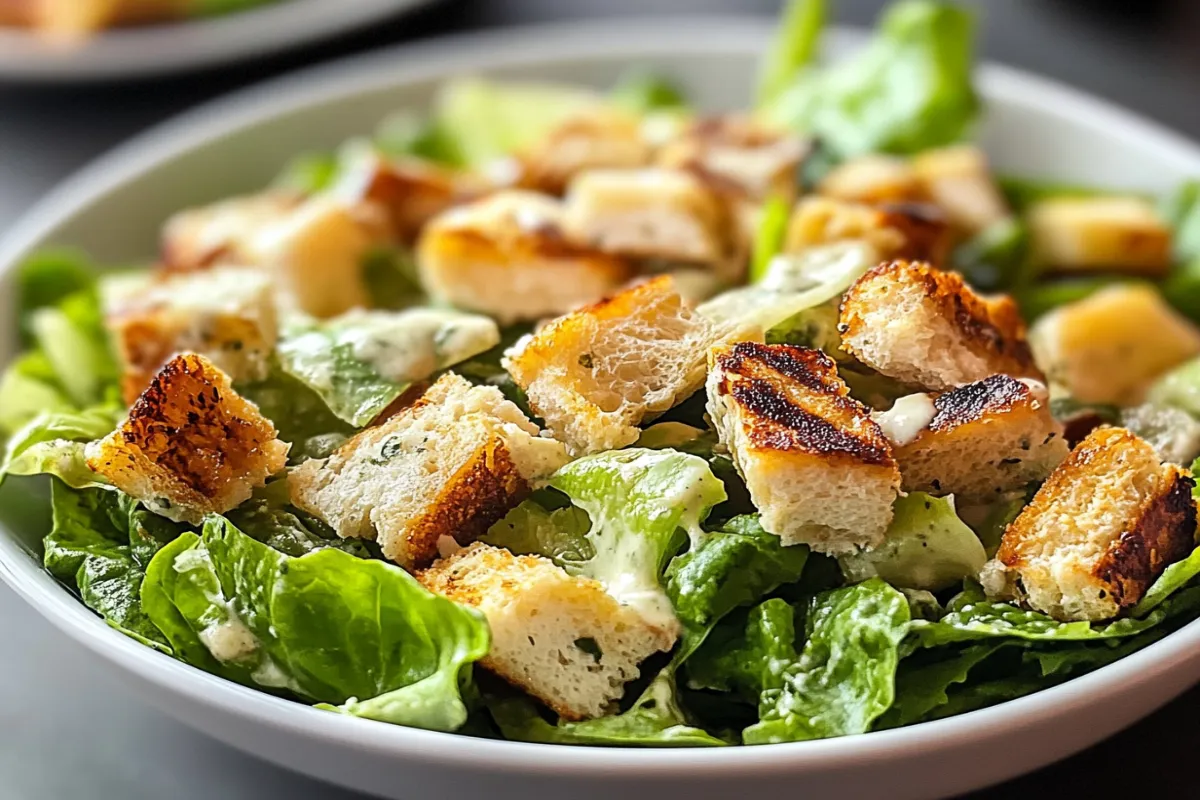Caesar salad is a beloved classic, known for its delicious combination of fresh greens, crunchy croutons, rich Parmesan cheese, and savory, creamy dressing. Whether you’re enjoying it as a starter or as a main course with added protein, this salad has a unique flavor that appeals to many. But what exactly makes up a Caesar salad, and how did it become such a culinary staple?
Created in 1924 by Caesar Cardini in Tijuana, Mexico, the Caesar salad has become one of the most famous dishes in the world. The original recipe is simple yet sophisticated, blending textures and flavors in a way that makes it both satisfying and refreshing. For those looking to explore how romaine lettuce fits into this classic dish, or for guidance on how to make your own dressing, you can learn more about romaine lettuce and its uses here or check out this guide to homemade Caesar dressing to start creating your own Caesar masterpiece.
In this article, we will break down each element of a Caesar salad, explore its history, discuss variations, and even provide tips for making your own at home. Let’s dive into what makes a Caesar salad truly special and how you can bring it to life in your kitchen.
Key Ingredients of Caesar Salad
The classic Caesar salad is composed of a few core ingredients that give it its signature taste. These components are simple but combine to create a delicious balance of creamy, salty, tangy, and crunchy.
1. Romaine Lettuce
At the base of any Caesar salad is romaine lettuce, chosen for its crisp texture and slightly bitter flavor. The sturdy leaves of romaine hold up well under the rich Caesar dressing, maintaining their crunch even when coated. If you’re seeking alternatives, some people swap in kale or spinach for a twist on the traditional recipe, but romaine remains the gold standard for an authentic Caesar.
2. Parmesan Cheese
Parmesan cheese is a key element of a Caesar salad, providing a sharp, salty taste that complements the creaminess of the dressing. Freshly grated or shaved Parmesan is preferred, as it offers the best flavor and texture. If you can’t find Parmesan, Grana Padano or Pecorino Romano are excellent substitutes.
3. Croutons
Croutons add the crunchy texture that contrasts beautifully with the creamy dressing and crisp lettuce. Traditional Caesar salad croutons are made from cubed, toasted bread, often seasoned with garlic and olive oil. For those who want to add a healthy twist, using whole-grain bread to make homemade croutons is a great option.
4. Caesar Dressing
The dressing is what ties a Caesar salad together. A classic Caesar dressing is made from egg yolks, olive oil, lemon juice, Worcestershire sauce, mustard, garlic, and anchovies. These ingredients are whisked together to create a creamy, tangy, and savory dressing that is the hallmark of the dish. Variations on the dressing can include lighter versions using Greek yogurt or mayonnaise instead of egg yolks, but the anchovies and garlic are essential for that classic Caesar taste.
Variations of Caesar Salad

While the traditional Caesar salad remains a popular choice, many people have experimented with variations that suit different tastes and dietary needs. Here are a few of the most common adaptations.
1. Chicken Caesar Salad
One of the most popular versions of the Caesar salad is the addition of grilled chicken. Adding chicken boosts the protein content, making the salad more filling and suitable as a main course. The chicken is usually seasoned simply with salt, pepper, and olive oil, allowing the dressing and Parmesan to shine.
2. Kale Caesar Salad
For a modern twist on the classic, some swap out romaine lettuce for kale. Kale’s hearty leaves stand up well to the dressing and provide more vitamins and fiber than romaine. This variation has become popular for those seeking a healthier, nutrient-packed option without sacrificing flavor.
3. Seafood Caesar Salad
For seafood lovers, adding grilled shrimp, salmon, or crab to a Caesar salad can elevate the dish to a gourmet level. The light, fresh taste of seafood pairs well with the tangy Caesar dressing and adds an elegant touch to the meal.
Nutritional Breakdown of Caesar Salad
While delicious, it’s important to understand the nutritional content of a Caesar salad, especially if you’re looking to make healthier choices or adapt the recipe to suit your dietary needs.
Calories and Macronutrient Content
A traditional Caesar salad, when served without protein, typically contains around 300-400 calories. Much of the calorie content comes from the Caesar dressing and croutons, which are rich in fats and carbohydrates. When you add grilled chicken or seafood, the calorie count can increase to 500-600, but it also boosts the protein content significantly.
Health Benefits
Despite its relatively high calorie content, Caesar salad provides a number of health benefits. Romaine lettuce is rich in vitamins A and K, while Parmesan cheese offers calcium and protein. Additionally, if you make your dressing from scratch using olive oil, you’ll get a dose of healthy fats, which are good for heart health.
Potential Drawbacks
The main concerns with Caesar salad lie in its potential for high sodium and saturated fat levels, especially from the dressing and cheese. Store-bought dressings can also contain preservatives and excess sugar. To keep the salad healthier, opt for homemade dressing and limit the amount of croutons or cheese.
Step-by-Step Guide to Making Caesar Salad

Making your own Caesar salad at home is simple and allows you to control the quality of the ingredients. Here’s how you can make a classic Caesar salad from scratch:
Step 1: Prepare the Dressing
The dressing is the heart of a classic Caesar salad, providing the signature creamy and tangy flavor that binds all the ingredients together. Making your own Caesar dressing from scratch ensures you get the freshest, most flavorful result, without any unnecessary additives or preservatives.
Here’s how to prepare the perfect Caesar dressing:
- Egg Yolks: Start by whisking together 2 egg yolks in a mixing bowl. The egg yolks serve as the base, creating the rich, creamy texture that defines the dressing.
- Dijon Mustard: Add 1 teaspoon of Dijon mustard to the egg yolks. The mustard not only adds a hint of spice but also helps to emulsify the dressing, ensuring a smooth consistency.
- Garlic: Mince 2 garlic cloves and add them to the mixture. Garlic is a key flavor component, offering a bold, aromatic taste that complements the richness of the other ingredients.
- Worcestershire Sauce: Stir in 1 tablespoon of Worcestershire sauce, which brings a deep, savory flavor with just a touch of sweetness. This sauce enhances the umami notes of the dressing.
- Lemon Juice: Add the juice of 1 lemon to brighten the flavors and balance out the richness of the yolks and oil. The acidity of the lemon cuts through the creaminess, adding a zesty tang.
- Olive Oil: While whisking continuously, slowly drizzle in 1/3 cup of olive oil. This step is crucial for emulsifying the dressing, as it thickens and smooths out the texture. The slow addition of oil ensures that the ingredients blend perfectly, preventing the dressing from separating.
- Season: Finally, season the dressing with salt and pepper to taste. You can also add a dash of extra Parmesan cheese if you prefer a richer flavor.
Pro Tip:
- For a smoother dressing, you can blend all the ingredients in a food processor. This method is especially helpful for fully incorporating the garlic and ensuring the dressing is creamy.
Once your dressing is fully emulsified, it’s ready to be drizzled over your salad. The homemade dressing will last in the fridge for about 3-4 days, so you can make it ahead of time if needed. This step ensures that every bite of your Caesar salad is bursting with the fresh, tangy flavors that make this dish a classic.
Step 2: Make the Croutons
To make homemade croutons:
- Cut a French baguette into small cubes.
- Toss the cubes with olive oil, minced garlic, and Parmesan cheese.
- Spread them evenly on a baking sheet and bake in the oven at 350°F (175°C) for 10-15 minutes, or until they are golden brown and crispy.
Step 3: Assemble the Salad
In a large bowl, combine the romaine lettuce, freshly prepared croutons, and Parmesan cheese. Drizzle with the dressing and toss gently to coat the lettuce evenly.
Step 4: Garnish and Serve
For a finishing touch, garnish the salad with more Parmesan shavings and a light squeeze of lemon juice. Serve immediately to ensure the croutons stay crispy.
FAQs About Caesar Salad
1. Why is Caesar Salad Dressing Creamy?
The creamy texture of Caesar dressing comes from the emulsification of egg yolks and olive oil. As the oil is whisked into the egg yolks, the dressing thickens, creating a smooth, velvety consistency.
2. Can I Make Caesar Salad Without Anchovies?
Yes, you can! If you’re not a fan of anchovies, you can substitute them with Worcestershire sauce, which still provides that savory, umami flavor without the fishiness. Another option is to omit the anchovies altogether, though the dressing will have a milder flavor.
3. How Do I Make Caesar Salad Healthier?
To make Caesar salad healthier, you can reduce the amount of dressing, use lighter dressing alternatives (such as those made with Greek yogurt), and add more nutrient-dense vegetables like kale or spinach. You can also make baked whole-grain croutons to cut down on calories and add fiber.

Conclusion: The Perfect Balance of Flavors and Textures
Caesar salad is more than just a simple dish—it’s a balance of textures, flavors, and freshness that can be enjoyed as a light starter or a hearty meal. By understanding the core ingredients and how they come together, you can create your own perfect version of this classic salad. Whether you stick to the traditional recipe or experiment with variations like kale or chicken Caesar salad, you can’t go wrong with the timeless appeal of this dish.
If you’re ready to elevate your salads, try making your own homemade Caesar dressing or adding grilled shrimp for a luxurious twist. For even more salad inspiration, you can explore this Chicken Mango Avocado Salad, another great way to combine fresh ingredients into a flavorful, satisfying meal.

